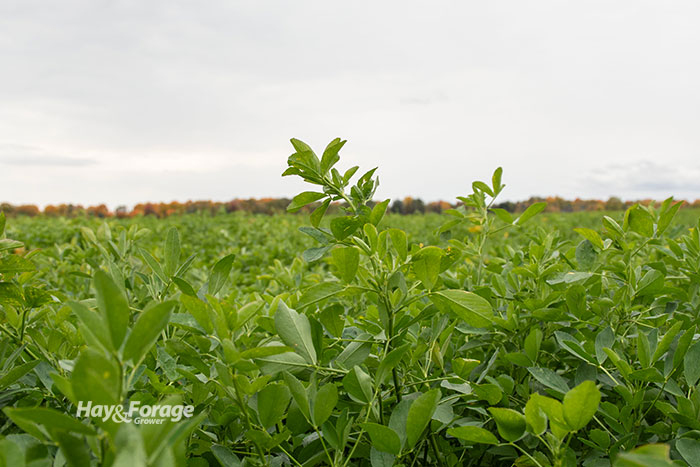
Even with haying equipment parked in the shed for the season, the wheels of forage management shouldn’t stop turning. The period between the final cutting of alfalfa and when plants enter winter dormancy is a good time to evaluate stands and prepare for next year.
In a recent issue of the Midwest Forage Association’s Clippings newsletter, Dan Undersander provides a fall checklist to help promote alfalfa’s winter survival. The emeritus professor and forage specialist with the University of Wisconsin-Madison also offers advice for rotating alfalfa that is at high risk of winterkill.
Assess plant height. Undersander notes alfalfa that is more than 15 inches tall should have enough carbohydrates stored in its crown to successfully endure the cold weather. Likewise, if producers took a late fall cutting, plants that are 6 inches or shorter probably haven’t depleted their energy reserves for regrowth. Alfalfa that measures in between these markers may be in a weaker position to survive the winter.
“Height between 6 to 15 inches indicates regrowth with minimal carbohydrate replenishment, which will reduce winter survival and/or yield of first cutting next spring,” Undersander asserts.
Calculate stem density. Optimum alfalfa yields are realized when there is a minimum of 55 stems per square foot. That said, a stand with 40 or fewer stems per square foot could experience a 25% or greater yield reduction the following year. If this is the case, producers might consider terminating forage and plant a rotation crop in its place, especially if winterkill could worsen the outcome.
“If stem density is low, it might be worthwhile to plan on turning the stand over and seeding new fields,” Undersander suggests.
Kill winter annual weeds. An adequate stem density can justify fall herbicide applications if winter annual weed populations are high; however, this issue can also support the argument to terminate thin alfalfa stands. Either way, Undersander recommends controlling weeds and volunteer small grain crops in new fall seedings to promote a denser hayfield next year.
Address nutrient deficiencies. Fertilize existing stands to replace nutrients removed during hay harvest. Undersander points out approximately 5 pounds of sulfur and up to 55 pounds of potassium are removed from a field with each dry ton of harvested forage. Calculate total alfalfa yield from the previous season and subtract how much fertilizer has already been applied to estimate nutrient deficiencies. Then, apply any additional fertilizer before the ground freezes this fall or early next spring.
Take a soil test to check soil pH in fields where alfalfa will be seeded. Undersander recommends applying lime yet this fall if pH levels are below 6.6. Doing so will allow the nutrient more time to take effect before planting season begins.
Be proactive. After inspecting individual stands, take stock of the entire forage system. Consider overall alfalfa acreage and determine which corn or soybean fields will be seeded to alfalfa in the spring. Avoid seeding alfalfa in fields where herbicide with a long-lasting residual was applied and check the product label for more specific restrictions. Then, think ahead to herbicide applications in 2024 and plan to use products with less than 12-month residuals where alfalfa will be seeded in 2025.

